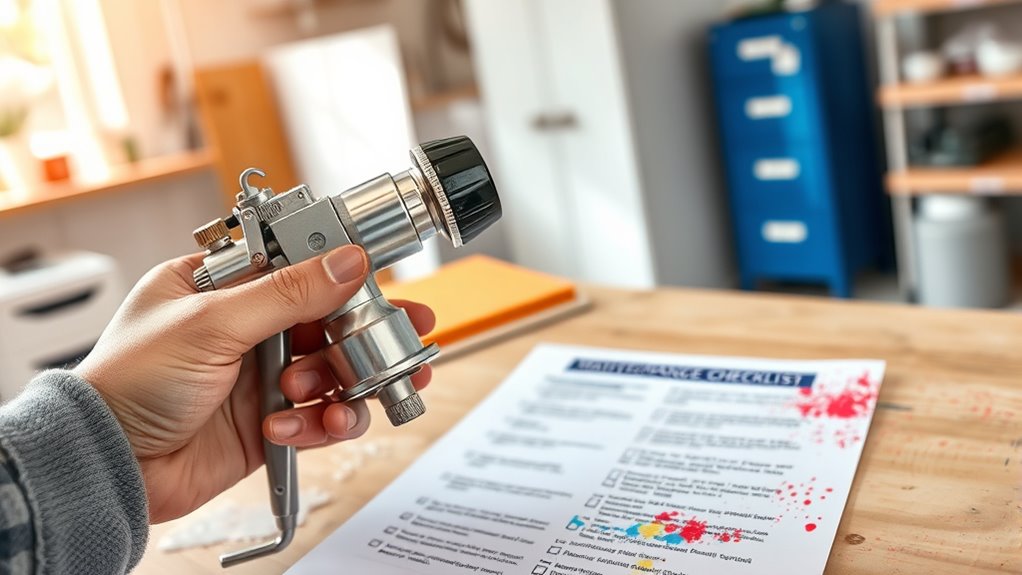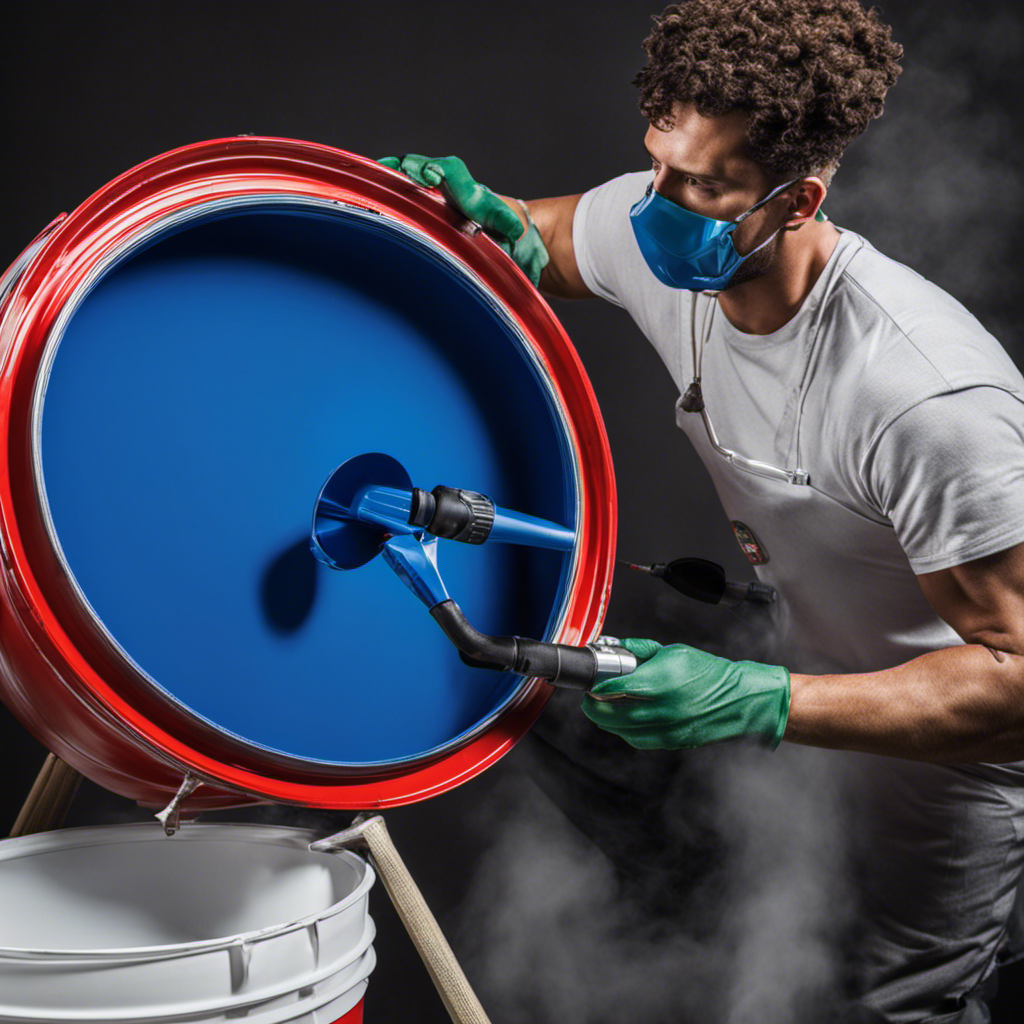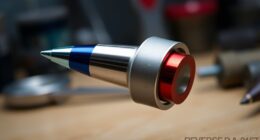To extend your paint sprayer’s lifespan, keep it clean by flushing and thoroughly cleaning after every use. Check and replace worn parts, like seals and nozzles, and lubricate moving components regularly. Inspect hoses and connections for damage and tighten them. Store your sprayer in a dry place, and use proper paint thinning techniques to prevent clogs. Following these maintenance routines will help your sprayer perform better and last longer, so keep going to learn more tips.
Key Takeaways
- Perform regular cleaning and flushing after each use to prevent paint buildup and clogs.
- Inspect and replace worn or damaged parts like seals, nozzles, and hoses promptly.
- Lubricate internal components and moving parts according to manufacturer recommendations.
- Clean and inspect nozzles and spray tips after every session for consistent spray quality.
- Store equipment properly in a dry, clean environment and drain residual paint before long-term storage.
Regularly Clean the Spray Gun and Nozzles
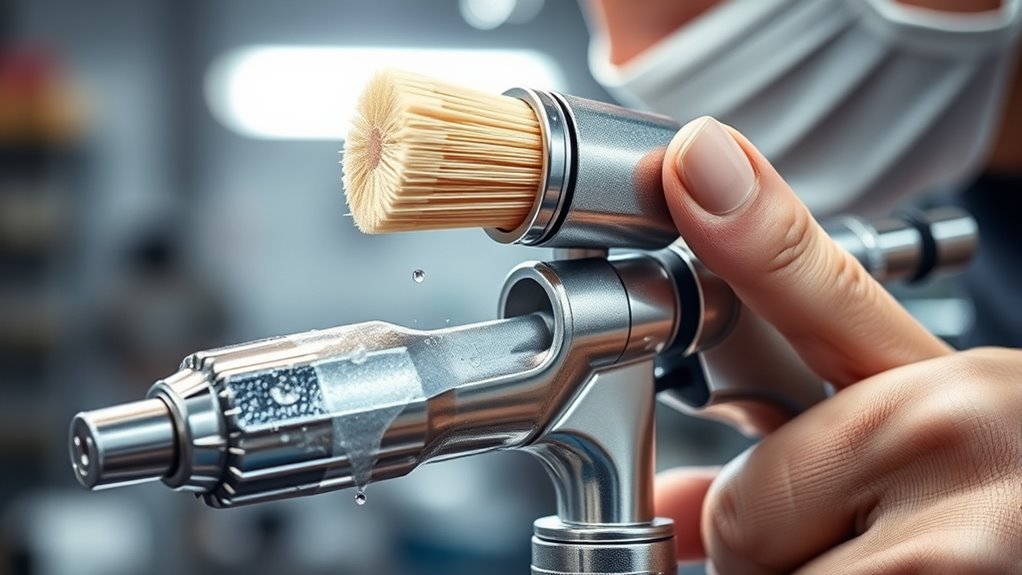
To guarantee your paint sprayer performs at its best, you need to regularly clean the spray gun and nozzles. Start by thoroughly rinsing the spray gun after each use to remove residual paint. Use cleaning brushes to scrub hard-to-reach areas, ensuring no clogs develop. Properly cleaning the nozzles prevents buildup that can affect spray quality. After cleaning, dry all parts thoroughly before storing. Storing accessories properly, such as nozzles and brushes, in a clean, dry place helps prevent rust and damage. Regular maintenance not only extends your sprayer’s lifespan but also ensures smooth operation and consistent results. Make a habit of cleaning your spray gun and nozzles promptly to avoid future issues and keep your equipment in excellent condition. Additionally, incorporating routine maintenance practices can help identify potential problems early and prevent costly repairs, maintaining optimal performance over time. Performing proper cleaning techniques based on the type of paint used can further prolong the life of your equipment and ensure its longevity, especially when using different painting materials and solvents. Regular inspection of spray gun components can also reveal signs of wear that need attention before they cause larger issues.
Inspect and Replace Worn or Damaged Parts
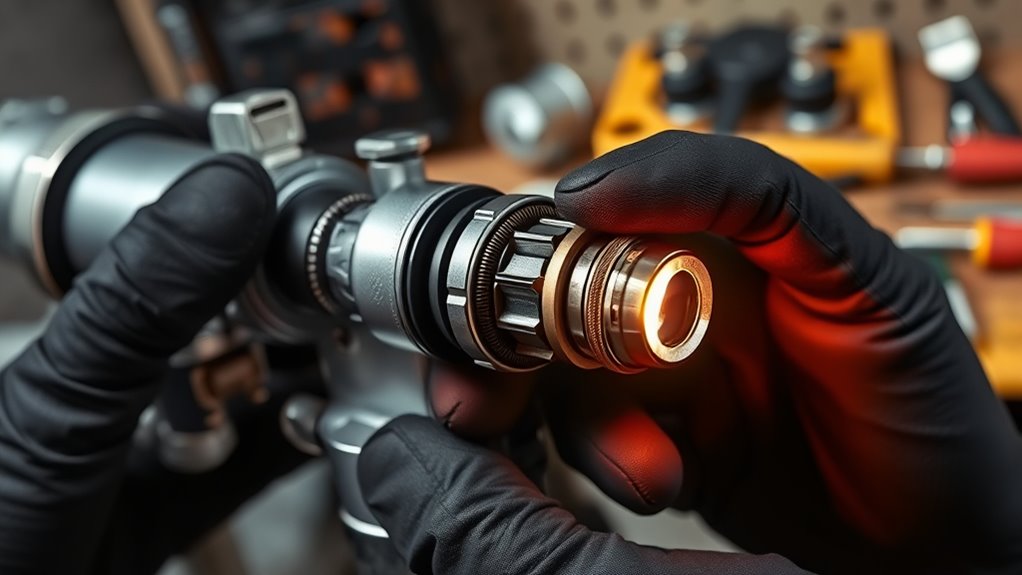
You should regularly inspect your sprayer for signs of wear or damage to guarantee it works properly. Look closely for cracks or any other visible issues that could affect performance. If you find damaged parts, replace them promptly to keep your sprayer in top shape. Additionally, ensuring your equipment is well-maintained can prevent issues caused by poor insulation or outdated components, which can impact efficiency and longevity. Regularly checking for component deterioration can help identify potential problems before they lead to failure. Incorporating routine checks for corrosion or build-up can further extend the lifespan of your sprayer and maintain optimal operation. Staying informed about security in payment processing can help avoid potential vulnerabilities that could compromise your equipment or data. Proper maintenance practices can also help avoid issues that compromise the performance of your equipment, ensuring consistent results over time.
Visual Wear Inspection
Regularly inspecting your paint sprayer for worn or damaged parts is essential to guarantee peak performance and prevent costly repairs. Focus on the visual component of each part, checking for signs of wear, cracks, or deformation. Pay close attention to surface integrity, ensuring no corrosion, chips, or surface erosion compromise the sprayer’s efficiency. Look for discoloration, pitting, or other visible damage that could affect spray quality. If you notice any irregularities, replace the affected parts promptly to maintain proper function. This routine visual wear inspection helps you catch issues early, prolongs your sprayer’s lifespan, and ensures consistent, high-quality application. Regular checks keep your equipment reliable and avoid sudden breakdowns that could disrupt your work. Additionally, staying aware of heat pump noise levels can help you identify if any components are malfunctioning, potentially indicating the need for maintenance. Monitoring equipment vibrations can also serve as an early warning sign of mechanical issues that require attention. Incorporating preventive maintenance practices and understanding the importance of filter replacement and cleaning can further extend the life of your paint sprayer and optimize performance. Incorporating routine lubrication of moving parts can reduce wear and improve the sprayer’s longevity.
Check for Cracks
Inspecting your paint sprayer for cracks is a key step in maintaining ideal performance. Carefully examine all visible parts, focusing on areas prone to stress, such as hoses, seals, and the sprayer body. A small paint crack might seem minor but can cause leaks or uneven spray patterns, so don’t ignore any signs of damage. Look for any cracks in the housing or connections that could compromise the sprayer’s integrity. A sprayer crack can lead to reduced pressure or messy application, so spotting these early helps prevent bigger issues. If you find any cracks, address them promptly to avoid further damage. Regularly checking for cracks ensures your sprayer operates smoothly and prolongs its lifespan. Additionally, understanding tuning options for your vehicle can help you optimize performance and prevent mechanical issues that might indirectly affect your equipment. Being aware of maintenance practices for your tools also contributes to longer-lasting performance. Recognizing potential wear and tear helps anticipate problems before they escalate. Performing routine inspections and proper storage can further protect your equipment from developing cracks over time. Incorporating visual inspections into your routine can help catch minor issues before they become serious.
Replace Damaged Parts
When you notice signs of wear or damage on your paint sprayer, it’s essential to substitute those parts promptly to maintain peak performance. Damaged components can cause uneven spray, clogs, or motor strain. To ensure proper function, follow these steps:
- Identify worn or cracked parts, such as seals or nozzles.
- Use only custom replacement parts designed for your model for a perfect fit.
- Check if your warranty coverage includes free or discounted replacements.
- Regularly inspect hoses and filters, replacing them when damaged.
- Incorporate preventive maintenance practices, like cleaning and lubricating moving parts, to extend the lifespan of your sprayer. Additionally, keeping internal components well-maintained prevents premature wear and ensures consistent spray quality. Implementing routine inspections can help catch potential issues before they cause significant damage. Staying informed about support hours and service options can also help you obtain assistance quickly if repairs are needed.
Replacing damaged parts promptly keeps your sprayer running smoothly and prevents more costly repairs. Using genuine or custom replacement parts ensures durability and compatibility, while warranty coverage can help reduce expenses. Staying proactive preserves your sprayer’s lifespan and performance.
Flush the System After Each Use
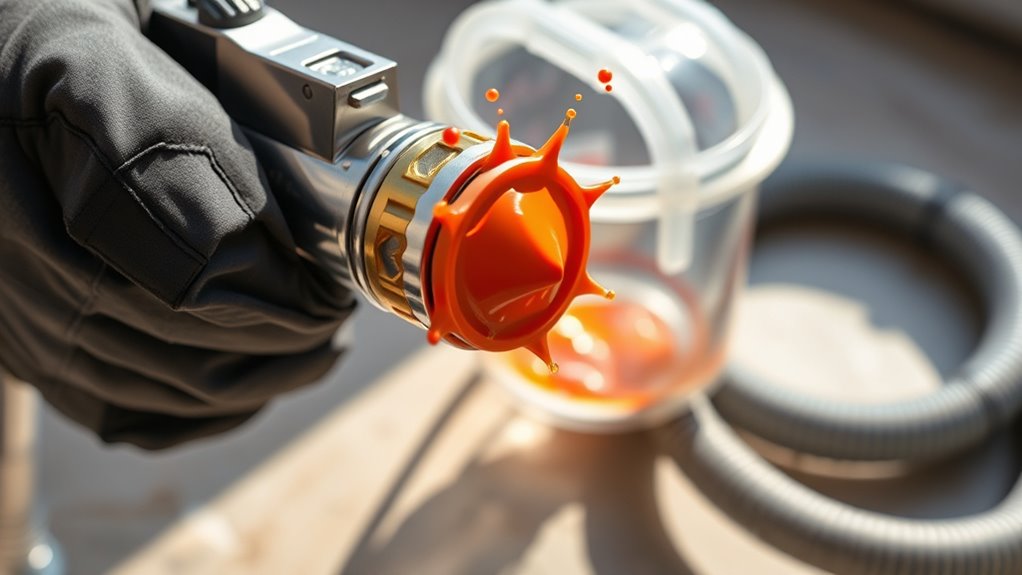
After each use, it’s vital to flush the system to prevent paint from drying inside the sprayer. This step keeps your equipment in top shape and guarantees consistent results. Begin by cleaning brushes thoroughly to remove residual paint, which helps maintain smooth operation. Flushing also helps optimize paint viscosity, making it easier to spray and reducing clogs. Use water or the appropriate solvent for the type of paint you used, running it through the system until it runs clear. Don’t forget to clean the spray gun, hoses, and filters afterward. Properly flushing after each session prevents buildup, prolongs your sprayer’s lifespan, and saves you time on future maintenance. Regular filtration and pump protection prevent clogs and ensure efficient operation. Make this routine part of your cleaning process for peak performance.
Lubricate Moving Components
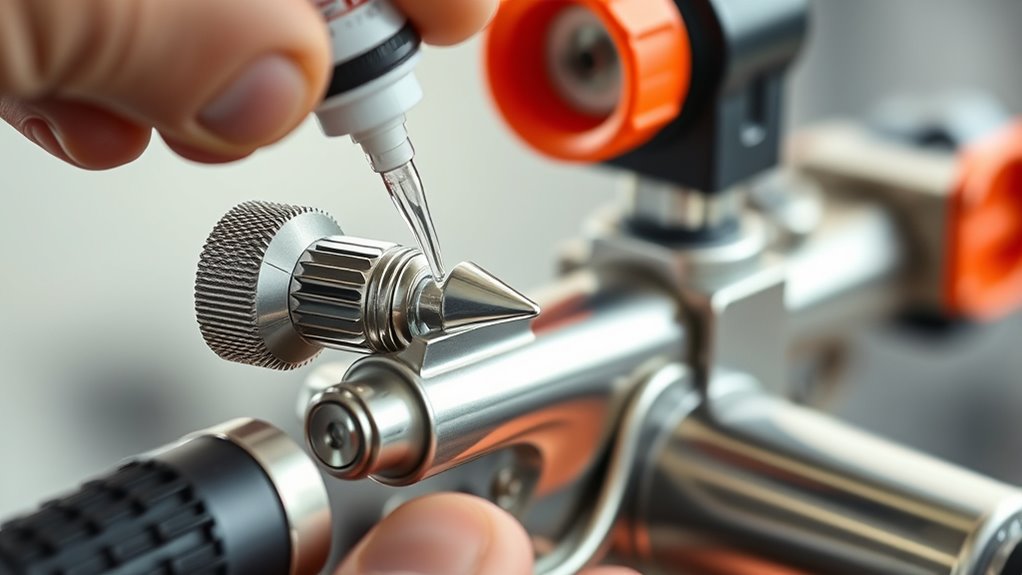
Proper lubrication of the moving components in your paint sprayer keeps everything functioning smoothly. Following a consistent lubrication schedule ensures your moving parts operate without friction or wear. Regularly lubricate these key areas:
- Gear mechanisms
- Pistons and cylinders
- Trigger and trigger assembly
- Pump shaft and bearings
Use the recommended lubricant specified in your user manual for ideal results. Applying lubricant too infrequently can cause parts to seize, while over-lubricating may attract dust and debris. Additionally, preventing corrosion is essential for maintaining the longevity of your equipment, so ensure all metal parts are properly protected. Focus on the moving parts that experience the most friction, and check them regularly. This simple maintenance step helps prevent costly repairs and extends your sprayer’s lifespan. Proper lubrication is especially important for wear and tear prevention, ensuring your equipment remains in optimal condition over time. Keep your equipment in top shape by sticking to your lubrication schedule and maintaining well-lubricated moving parts.
Check and Tighten Connections and Hoses
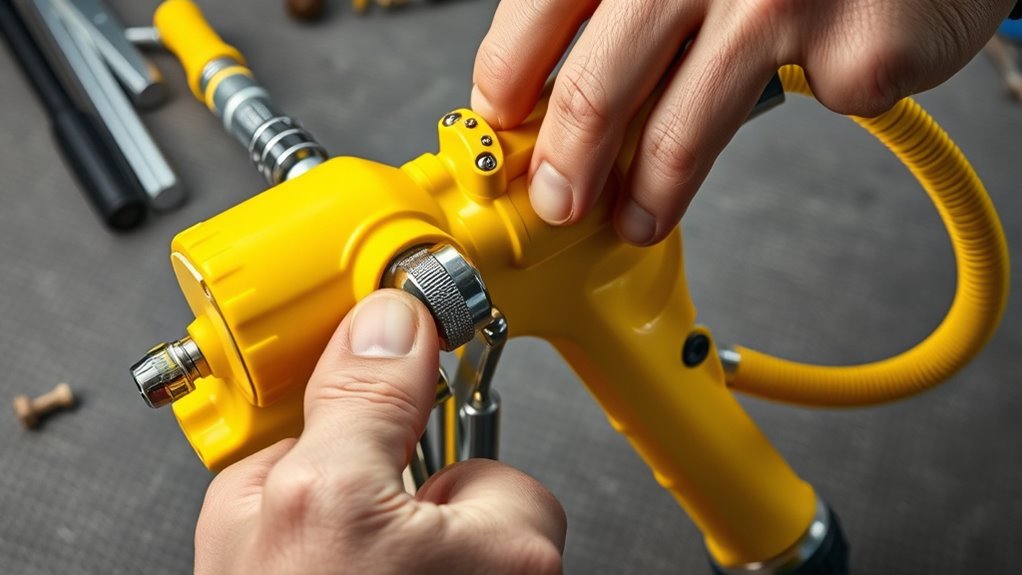
Regularly checking and tightening connections and hoses guarantees your paint sprayer operates safely and efficiently. Start with connection checks by inspecting all fittings, ensuring they’re secure and free from leaks or cracks. Loose connections can cause uneven spray patterns or pressure loss, so tighten any that feel loose, but avoid over-tightening, which can cause damage. During hose maintenance, examine hoses for signs of wear, cracks, or leaks, and replace damaged ones immediately. Ensure all clamps and fittings are properly attached to prevent airflow or paint flow disruptions. Properly maintained connections and hoses help maintain consistent pressure, reduce clogs, and prevent accidents. Regular maintenance of these parts keeps your sprayer functioning smoothly and extends its overall lifespan.
Store Your Sprayer Properly
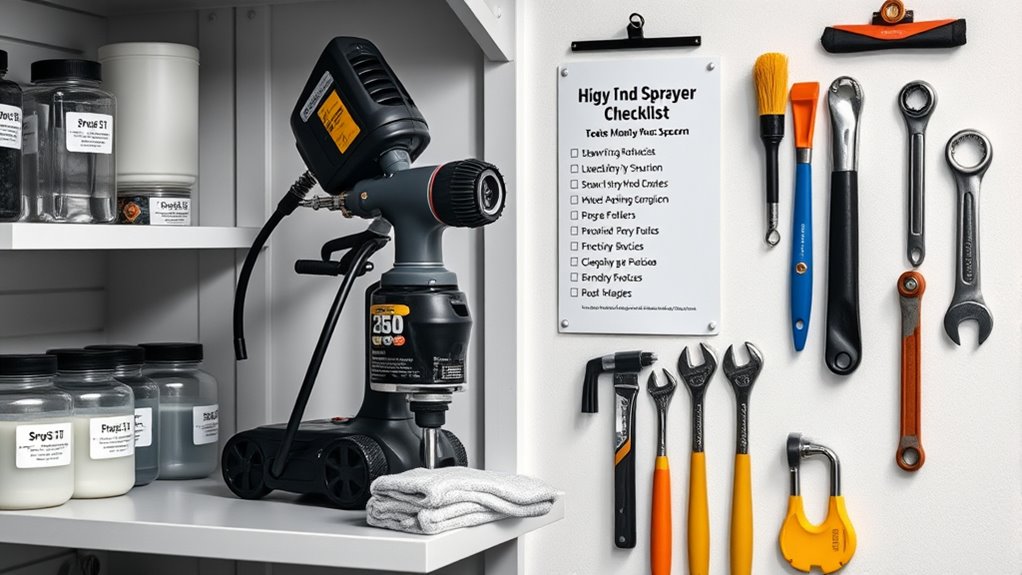
To guarantee your paint sprayer remains in good condition, you need to store it properly when not in use. Proper storage helps prevent damage and ensures longevity. Follow these storage tips:
- Clean your sprayer thoroughly before storing to remove paint residue.
- Drain any remaining paint and cleaners to avoid clogging.
- Store the sprayer in a dry, cool place to prevent rust and deterioration.
- Use protective covers to shield it from dust, dirt, and potential impacts.
Always ensure the sprayer is completely dry before covering it, and avoid storing in areas with extreme temperatures. Proper storage, including the use of protective covers, preserves your equipment and extends its lifespan, ready for your next project.
Use the Right Paint and Thinning Techniques
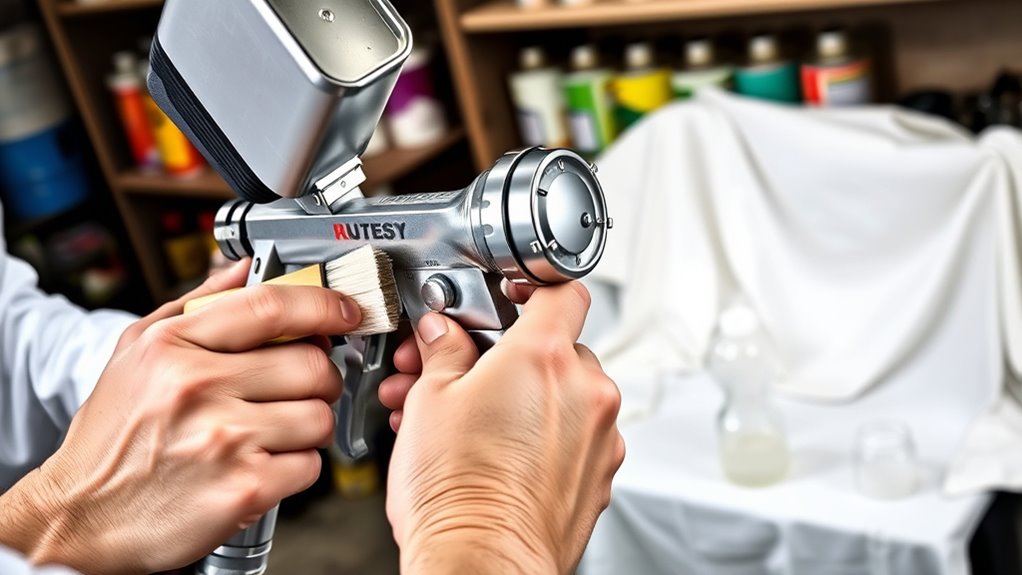
Using the right paint and thinning techniques guarantees your sprayer works efficiently and produces a smooth finish. You need to select compatible paint types and mix them properly to avoid clogs or uneven spraying. Consistently applying recommended thinning ratios helps you achieve the best results every time.
Select Compatible Paint Types
Are you choosing the right paint for your sprayer? Ensuring proper coating selection and paint compatibility is key to prolonging your sprayer’s life. Select paints that are compatible with your equipment to prevent clogs and damage. Consider these tips:
- Check the manufacturer’s guidelines for compatible paint types.
- Use water-based or solvent-based paints suited to your sprayer’s specs.
- Avoid thick or overly pigmented coatings that can clog nozzles.
- Match the paint’s viscosity to your sprayer’s recommended settings.
Properly Thin Paint Consistently
Properly thinning paint is essential for achieving smooth, even coatings and preventing nozzle clogs. Consistent paint consistency ensures your sprayer operates smoothly, reducing issues and extending its lifespan. To maintain this consistency, use proper thinning techniques tailored to your paint type. Start by adding small amounts of thinner gradually, mixing thoroughly after each addition. Always check the paint’s viscosity with a flow test before spraying; it should flow smoothly without dripping or thickening. Avoid over-thinning, which can lead to runs and uneven coverage. By paying attention to your paint’s consistency and applying consistent thinning techniques, you’ll help your sprayer perform effectively, reduce wear and tear, and achieve professional-quality results every time.
Use Recommended Thinning Ratios
Do you know the importance of following recommended thinning ratios for your paint sprayer? Using the correct ratios guarantees smooth application and prevents clogging. When thinning paint properly, you’ll achieve better paint color matching and a consistent spray pattern adjustment. To do this effectively:
- Always check the manufacturer’s guidelines for specific ratios.
- Use the right thinning agent, like water or solvent, depending on the paint type.
- Mix thoroughly to avoid uneven consistency.
- Test the spray pattern on a scrap surface before starting your project.
Proper thinning helps maintain your sprayer’s longevity, reduces wear, and ensures your finish looks professional. Remember, over-thinning can cause drips, while under-thinning may clog the nozzle. Stay precise for ideal results.
Monitor and Maintain Air Supply and Pressure
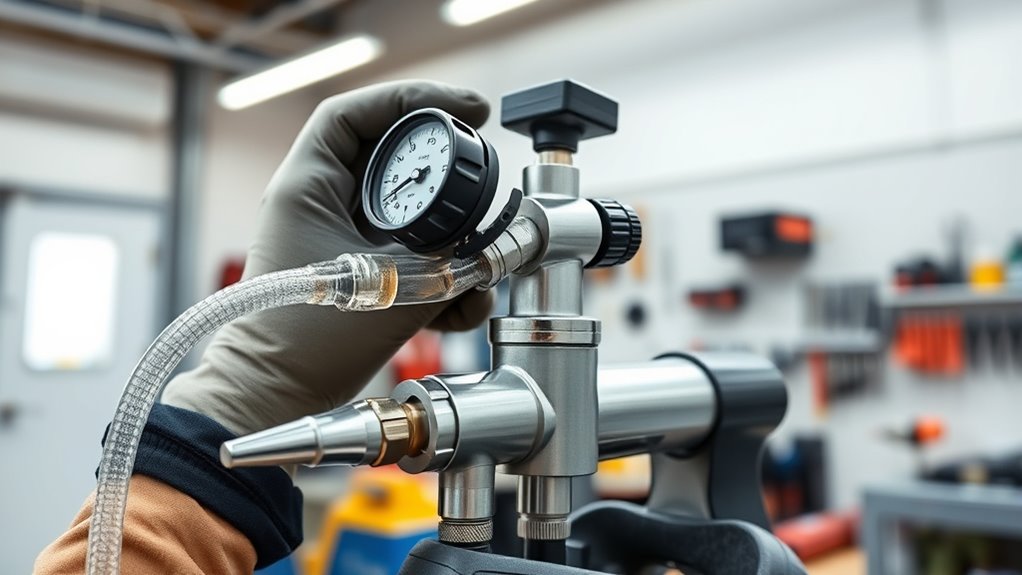
Maintaining a steady air supply and consistent pressure is essential for ideal spray gun performance. Regular air compressor maintenance helps prevent pressure drops or fluctuations that can affect your results. Check the compressor’s filters, hoses, and fittings for leaks or damage, and clean or replace parts as needed. Adjust the pressure regulator to ensure the pressure matches your sprayer’s specifications, preventing over- or under-pressurization. Consistently monitoring pressure levels during use helps avoid uneven spray patterns and paint wastage. Keep an eye on the compressor’s performance and listen for irregular noises that might indicate issues. By staying on top of air supply and pressure adjustments, you’ll extend your paint sprayer’s lifespan and achieve smoother, more professional finishes.
Schedule Routine Professional Servicing
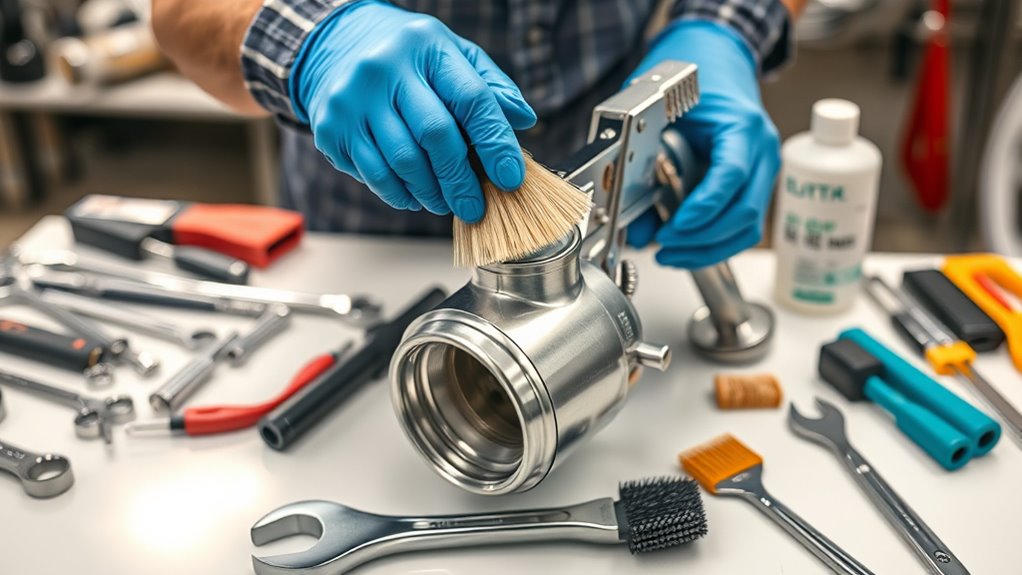
Regularly scheduling professional servicing for your paint sprayer guarantees it stays in top condition and performs consistently. Adhering to proper maintenance schedules ensures longevity and ideal results. When planning these services, consider the following:
- Schedule inspections at least every 6-12 months, depending on usage.
- Have a professional clean and replace worn parts during each visit.
- Check for any leaks, clogs, or pressure issues that may affect performance.
- Request a thorough assessment of internal components to prevent future breakdowns.
Frequently Asked Questions
How Often Should I Perform Maintenance on My Paint Sprayer?
You should perform maintenance on your paint sprayer regularly to keep it in top shape. After every use, clean the paint filter thoroughly and inspect the nozzle for clogs or damage. For frequent projects, perform these tasks weekly, and after heavy use, do a deeper clean. Consistent maintenance prevents clogs, extends your sprayer’s lifespan, and guarantees a smooth finish every time. Remember, a well-maintained sprayer works better and lasts longer.
What Signs Indicate My Sprayer Needs Professional Servicing?
While common troubleshooting and DIY repairs help keep your sprayer running, some signs signal you need professional servicing. If you notice inconsistent spray patterns, strange noises, or persistent clogging, it’s time to seek expert help. These issues often indicate internal problems beyond routine maintenance. Ignoring them can worsen damage, making repairs costlier. Trust your instincts—if DIY fixes don’t resolve the issue, professional servicing guarantees your sprayer stays in top shape.
Can I Use Generic Replacement Parts Without Affecting Performance?
You might wonder if using generic parts affects your sprayer’s performance. While they can be cost-effective, generic parts may not fit perfectly or meet the same quality standards, which could impact performance. To avoid issues, it’s best to check if the generic parts are compatible with your specific model and guarantee they meet quality standards. Using original parts often guarantees the best performance and durability.
What Safety Precautions Should I Follow During Maintenance?
When maintaining your paint sprayer, you should prioritize safety by wearing personal protective equipment like gloves, goggles, and a mask to prevent injuries or inhalation of fumes. guarantee your workspace is safe by setting up in a well-ventilated area, free of clutter, and with proper lighting. Always disconnect the sprayer from power before servicing, and follow the manufacturer’s safety instructions to avoid accidents.
How Do Environmental Conditions Impact Sprayer Longevity?
Environmental conditions considerably impact your sprayer’s longevity. Climate effects like extreme heat, cold, or humidity can cause parts to wear faster or rust. Poor storage conditions, such as leaving your sprayer outdoors or in damp areas, lead to corrosion and damage. To prolong its life, store your sprayer in a cool, dry place, and avoid exposing it to harsh weather. Proper care helps prevent costly repairs and keeps your sprayer working smoothly for longer.
Conclusion
By following this maintenance checklist, you’ll extend your paint sprayer’s lifespan just like tending a garden ensures vibrant blooms year after year. I once ignored regular cleaning, and my sprayer broke down during a big project—lesson learned. Think of your sprayer as a trusted tool that needs care; neglect it, and it won’t perform. Stay consistent, and your sprayer will deliver flawless results season after season.
A seasoned painter with over 15 years in the industry, Mike transitioned from hands-on painting projects to the digital world of paint sprayers. His extensive experience gives him a unique perspective on what users truly need when it comes to painting tools. As the Editor in Chief of Paint Sprayer Zone, Mike ensures that every piece of content not only provides value but also reflects the realities of painting — the challenges, the joys, and the intricate details.
